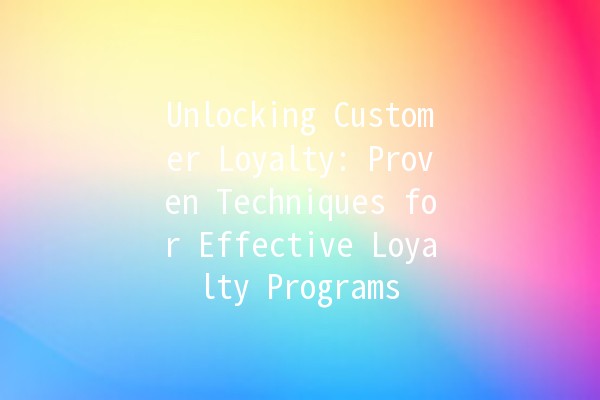In today's competitive market, businesses are constantly seeking innovative ways to attract and retain customers. A wellstructured loyalty program can transform occasional shoppers into brand advocates. This article explores effective strategies for designing loyalty programs that not only enhance customer retention rates but also drive longterm growth.
Importance of Loyalty Programs
Loyalty programs are not just about giving discounts; they’re a strategic tool for building relationships with customers. These programs create a bridge between brands and consumers, fostering a sense of belonging and appreciation. By effectively utilizing loyalty programs, businesses can increase customer lifetime value, encourage repeat purchases, and gather valuable data on consumer behavior.

Techniques to Enhance Loyalty Program Effectiveness
Personalization is at the heart of successful loyalty programs. Brands need to understand customer preferences and behaviors to tailor offers effectively.
Implementation: Utilize data analytics to segment customers based on their purchasing habits. For instance, if a customer frequently buys outdoor gear, offer them early access to new product launches in that category.
Example: Amazon excels in personalization by recommending products based on previous purchases, enhancing the shopping experience and often leading to increased sales.
Introducing gamelike elements into loyalty programs can significantly boost engagement. Gamification taps into human psychology, making the process of earning rewards enjoyable.
Implementation: Create a point system where customers earn points for every purchase. Set up tiers that unlock additional benefits, encouraging customers to strive for higher levels.
Example: Starbucks' rewards program is a classic example. Customers collect stars with every purchase, which can be redeemed for free drinks or food items, while also engaging in challenges for bonus stars.
Offering tiers in a loyalty program can motivate customers to increase their spending to reach the next level.
Implementation: Create three levels of membership (e.g., Silver, Gold, Platinum) with each tier offering different benefits.
Example: Sephora’s Beauty Insider program rewards customers with varying perks based on their spending levels. Highertier members receive exclusive products, birthday gifts, and invites to special events, making them feel valued.
Implementing feedback tools within the loyalty program can provide insights into customer preferences and improve future offerings.
Implementation: After each purchase or redemption, solicit feedback through surveys. Use this data to adjust the program based on customer needs and suggestions.
Example: Delta Airlines uses feedback to enhance its SkyMiles program, adapting their rewards based on customer travel habits and preferences, ensuring satisfaction and loyalty.
Collaborating with other complementary brands can expand the reach and attractiveness of a loyalty program.
Implementation: Partner with brands in related industries to provide more diverse rewards. For instance, a coffee shop could collaborate with a local bookstore, offering discounts at both venues.
Example: The Hilton Honors program allows members to earn points not just through hotel stays but also from dining and shopping at partner locations, creating a valuable network of rewards.
Optimizing Your Loyalty Program for SEO
To further enhance the impact of your loyalty program, ensure you leverage SEO strategies. Use relevant keywords related to your niche within the program's marketing materials and website content. Keywords such as "customer loyalty," "reward programs," and "loyalty discounts" can help improve your visibility online.
Common Questions About Loyalty Programs
The primary goal of a loyalty program is to increase customer retention and encourage repeat purchases. By rewarding customers for their loyalty, businesses can build stronger relationships, leading to enhanced customer lifetime value.
Success can be measured through metrics such as customer retention rates, repeat purchase frequency, and overall sales growth attributed to program members. Surveys and feedback can provide additional insights into customer satisfaction with the program.
While there is an upfront cost to establishing a loyalty program, the longterm benefits, including increased customer retention and higher average order values, often outweigh those initial costs. An effective program can lead to significant revenue growth over time.
Rewards should align with customer preferences and behaviors. Common reward types include discounts, free products, exclusive access to sales, and experiential rewards like events or trips.
Yes, small businesses can greatly benefit from loyalty programs. Even simple programs can encourage repeat purchases and build community loyalty, vital for sustainable growth.
While technology can enhance the effectiveness of a loyalty program, such as using apps for tracking rewards, basic programs can also be managed manually. The key is to ensure that the program is easy for customers to understand and engage with.
Creating an Engaging and Sustainable Loyalty Program
Building an effective loyalty program requires ongoing attention and adaptation. It’s important to keep the program fresh and engaging so that customers remain interested over time. Regularly assess what works and what doesn’t, and be willing to make changes based on consumer trends and feedback. By diligently focusing on innovation and customer engagement, you can cultivate a loyalty program that not only meets but exceeds expectations.
The potential of loyalty programs in today’s fastpaced marketplace is immense. By implementing the strategies discussed above, businesses can create compelling programs that foster lasting relationships with customers, driving both loyalty and profitability. The key lies in understanding your audience and continuously adapting to their needs and preferences—a commitment that will pay off substantially in the long run.